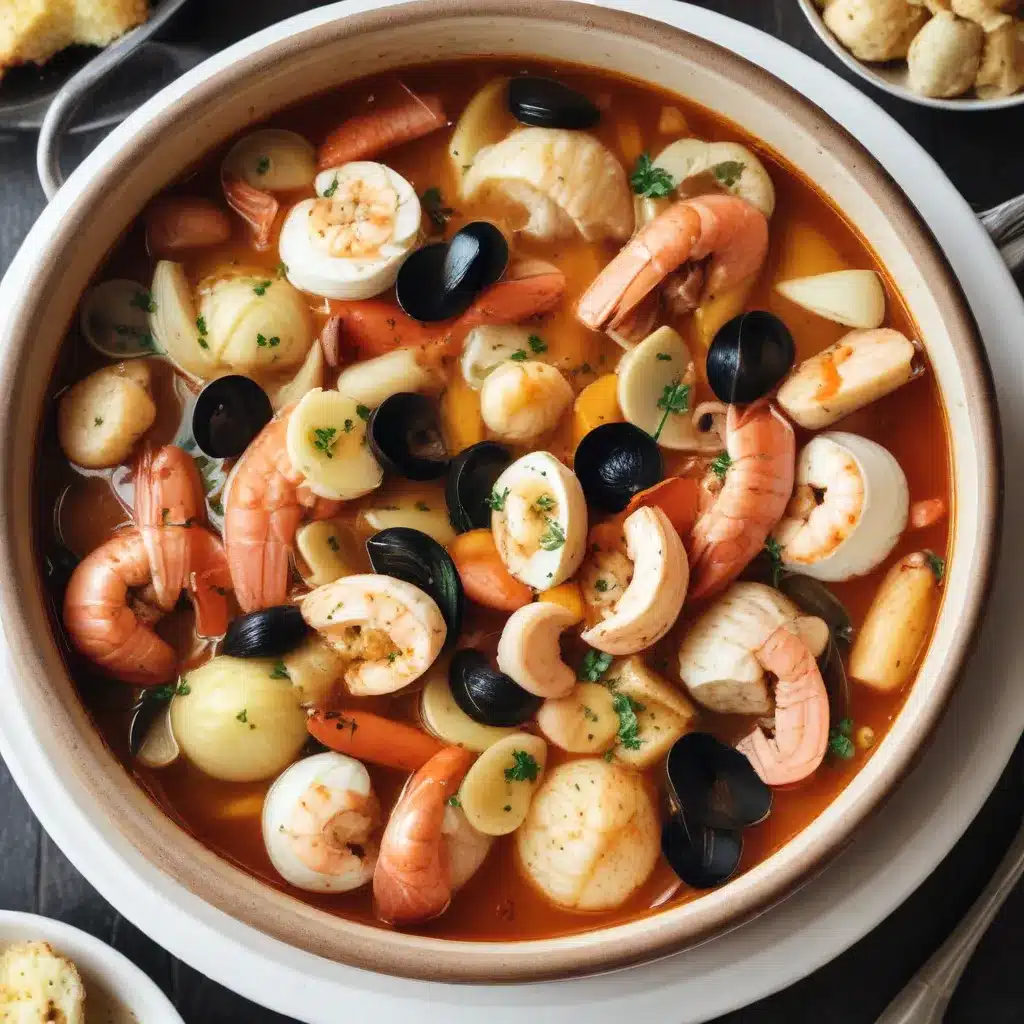
Bouillabaisse, the iconic French seafood stew, is a beloved dish that transports diners to the sun-drenched shores of Marseille. This robust, flavorful soup combines an array of fresh seafood simmered in a savory, saffron-tinged broth – a culinary treasure that has delighted taste buds for generations.
Seafood Varieties
The heart of bouillabaisse lies in the diversity of seafood that graces its broth. Traditionalists insist on a mix of local Mediterranean fish, such as red mullet, scorpionfish, and sea robin, along with plump mussels, clams, and shrimp. However, the beauty of this dish is its flexibility – you can incorporate a wide range of white fish, shellfish, and even lobster or crab, depending on what’s fresh and available in your region.
Broth Preparation
The foundation of bouillabaisse is its robust, aromatic broth. Fish bones, heads, and trimmings are simmered with onions, fennel, and tomatoes to create a rich, flavorful base. Saffron, an essential spice that lends the broth its signature golden hue and delicate floral notes, is added along with a touch of Pernod or pastis – an anise-flavored liqueur that enhances the overall complexity.
Seasoning and Herbs
Seasoning is paramount in bouillabaisse, with a harmonious blend of herbs and spices playing a crucial role. Garlic, thyme, bay leaves, and orange peel are common aromatics that infuse the broth with depth and nuance. A pinch of cayenne or paprika can add a subtle heat, while the judicious use of salt and pepper ensures the seafood’s natural sweetness shines through.
French Culinary Traditions
Bouillabaisse is a quintessential dish that embodies the rich culinary heritage of France, particularly the Provence region. This seafood stew has its roots in the modest fishing communities of Marseille, where resourceful cooks would utilize the day’s catch to create a hearty, nourishing meal.
Regional Specialties
Each coastal town in Provence has its own interpretations of bouillabaisse, reflecting the local seafood abundance and regional preferences. For instance, the version from Marseille is known for its use of a wider variety of fish, while the Cassis variation leans more heavily on rouille, a spicy saffron-garlic mayonnaise, as a key accompaniment.
Cooking Techniques
Traditionally, bouillabaisse was prepared using a specific technique called the “rouille,” where the fish was simmered in the broth until the bones could be easily removed, creating a rich, flavorful stock. Modern versions, however, often opt for a more streamlined approach, where the seafood is added in stages to ensure each element is cooked to perfection.
Presentation and Serving
Bouillabaisse is typically served in a large, shallow bowl, allowing the vibrant array of seafood to be on full display. Slices of crusty baguette or croutons are essential for sopping up the flavorful broth, while the rouille is often served as a condiment, to be spread on the bread or stirred directly into the soup.
Nutritional Benefits
Bouillabaisse is not only a delicious culinary experience but also a nutritional powerhouse. The seafood featured in this dish is an excellent source of protein, with many varieties also providing a bounty of omega-3 fatty acids, vitamins, and minerals. The tomato-based broth is rich in antioxidants and lycopene, while the saffron and herbs lend additional health-promoting properties.
Recipe Adaptations
While the traditional bouillabaisse recipe is a seafood lover’s delight, there are ways to adapt it to suit various dietary needs and preferences. For vegetarian or vegan versions, the seafood can be replaced with a combination of roasted vegetables, tofu, or plant-based protein sources, while the broth can be made with vegetable stock or broth. Those with gluten sensitivities can opt for gluten-free bread or rice as an accompaniment, or simply enjoy the stew on its own.
Serving Suggestions
Bouillabaisse is a complete meal in itself, but it can be enhanced with a variety of accompaniments. A simple green salad or fennel slaw can provide a refreshing contrast to the richness of the stew. And of course, no bouillabaisse experience is complete without the classic pairing of a crisp, chilled Provençal rosé or a Cotes du Rhone red wine.
History and Origins
The origins of bouillabaisse can be traced back to the humble fishing communities of Marseille, where resourceful cooks would combine the day’s catch into a hearty, nourishing stew. Over time, this dish evolved, incorporating Mediterranean influences and becoming a beloved culinary icon of the region.
Culinary Techniques
Mastering the art of bouillabaisse requires a delicate balance of culinary techniques. Proper seafood preparation, from cleaning and deveining shrimp to filleting fish, is crucial to ensure each component is cooked to perfection. The broth itself demands careful attention, with the gradual addition of ingredients and precise seasoning creating a harmonious symphony of flavors.
Regional Variations
While the Marseille-style bouillabaisse is the most well-known iteration, there are numerous regional variations that showcase the diverse culinary traditions of Provence. The Cassis version, for instance, often features a more pronounced use of rouille, while the Toulon variant may incorporate more tomatoes and saffron for a richer, more intense flavor profile.
Regardless of the specific regional differences, bouillabaisse remains a cherished culinary treasure that transports diners to the sun-drenched shores of the French Mediterranean. Whether enjoyed as a comforting meal or a celebratory feast, this hearty seafood stew is a testament to the enduring allure of French gastronomy. So, gather your freshest seafood and embark on a culinary journey to the heart of Provence with this classic bouillabaisse recipe.

